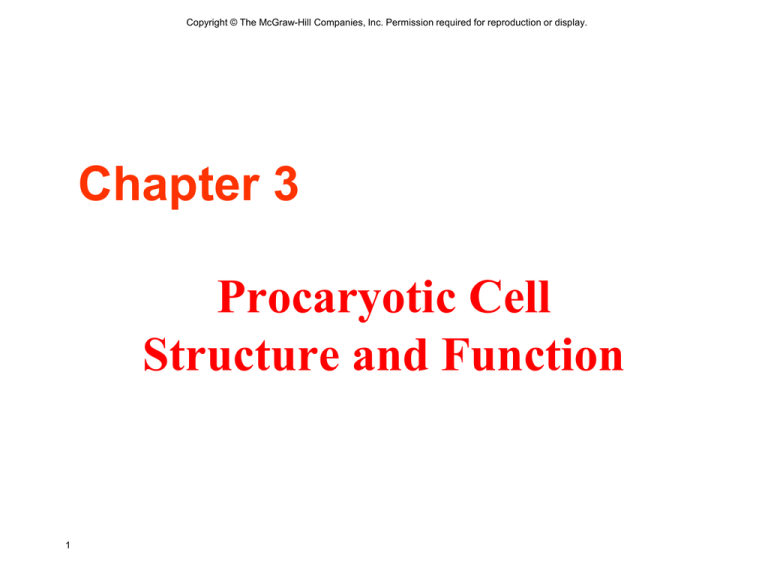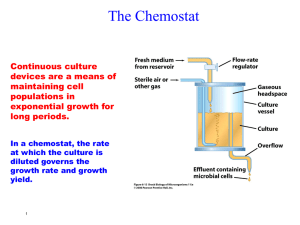
Copyright © The McGraw-Hill Companies, Inc. Permission required for reproduction or display.
Chapter 3
Procaryotic Cell
Structure and Function
1
A Preview of Procaryotic Cell
Structure and Function
• Procaryotes differ from eucaryotes in many
traits including size and lack of internal
membrane systems
• Procaryotes are divided into Bacteria and
Archaea
• Bacteria are divided into 2 groups based on
their Gram stain reaction
2
3
Copyright © The McGraw-Hill Companies, Inc. Permission required for reproduction or display.
Figure 3.2
4
Size, Shape, and Arrangement
– Cocci (coccus) – spheres
– Diplococci (diplococcus) – pairs
– Streptococci – chains
– Staphylococci – grape-like clusters
– Tetrads – 4 cocci in a square
– Sarcinae – cubic configuration of 8
cocci
5
Size, Shape, and Arrangement
• Bacilli (bacillus) – rods
-coccobacilli – very short rods
-vibrios – resemble rods, comma shaped
• Spirilla (spirillum) – rigid helices
• Spirochetes – flexible helices
• Mycelium – network of long,
multinucleate filaments
6
Size, Shape, and Arrangement
• Pleomorphic – organisms that are
variable in shape
7
Size
Size range for prokaryotes: 0.2 µm to > 700 µm in diameter
– Most cultured rod-shaped bacteria are between 0.5
and 4.0 µm wide and < 15 µm long
– Few very large prokaryotes; examples include
• Epulopiscium fishelsoni
• Thiomargarita namibiensis
• Size range for eukaryotic cells: 10 to > 200 µm in
diameter
8
9
•largest –
50 μm in
diameter
• smallest –
0.3 μm in
diameter
10
Figure 3.4
11
Procaryotic Cell Membranes
• Membranes are an absolute
requirement for all living organisms
• Plasma membrane encompasses the
cytoplasm
• Some procaryotes also have internal
membrane systems
12
Composition
• Phospholipids
• Contain both hydrophobic and hydrophilic
components
• Can exist in many different chemical forms
due to variation in the groups attached to the
glycerol backbone
• Fatty acids point inward to form hydrophobic
environment
13
Bacterial Phopholipids
• polar ends
– interact with
water
– hydrophilic
• nonpolar ends
– insoluble in
water
– hydrophobic
14
Figure 3.6
General Structure of Phospholipids
15
Functions of the plasma
membrane
• Separation of cell from its environment
• Selectively permeable barrier
– some molecules are allowed to pass into
or out of the cell
– transport systems aid in movement of
molecules
16
More functions…
• Location of crucial metabolic
processes
• Special receptor molecules in the
membrane
17
Fluid Mosaic Model of Membrane
Structure
• Lipid bilayer in which proteins float
Figure 3.5
18
Copyright © The McGraw-Hill Companies, Inc. Permission required for reproduction or display.
Membrane proteins
• Peripheral proteins
– loosely associated with the membrane
and easily removed
• Integral proteins
– embedded within the membrane and
not easily removed
19
Bacterial Membranes
• differ from eucaryotes in lacking sterols
– do contain hopanoids, sterol-like
molecules
• a highly organized, asymmetric system
which is also flexible and dynamic
20
Other membrane lipids
Figure 3.7
21
Internal Membranous Structures
• Plasma membrane infoldings
– Observed in many photosynthetic bacteria
– Nitrifying bacteria
– Methanotrophic bacteria
22
Plasma membrane
infoldings: observed in
many photosynthetic
bacteria
Figure 3.8
23
Archaeal membranes
• Composed of unique lipids
• Some have a monolayer structure instead
of a bilayer structure
24
Figure 3.9
25
Figure 3.10
26
Figure 3.11
27
Cytoplasmic Matrix
• Substance in which nucleoid, ribosomes
and inclusion bodies are suspended
• Lacks organelles bound by unit
membranes
• Composed largely of water
28
Inclusion bodies
• Granules of organic or inorganic
material that are stockpiled by the
cell for future use
• Some are enclosed by a singlelayered membrane
29
Organic inclusion bodies
• Glycogen
– polymer of glucose units
• Poly-β-hydroxybutyrate (PHB)
– polymers of β-hydroxybutyrate
30
Organic inclusion bodies
• cyanophycin granules
– large polypeptides containing about
equal quantities of arginine and
aspartic acid
• carboxysomes
– contain the enzyme ribulose-1,5,bisphosphate carboxylase (Rubisco),
enzyme used for CO2 fixation
31
Copyright © The McGraw-Hill Companies, Inc. Permission required for reproduction or display.
Figure 3.13
32
Organic inclusion bodies
• gas vacuoles
– found in cyanobacteria and some other
aquatic procaryotes
– provide buoyancy
– aggregates of hollow cylindrical
structures called gas vesicles
33
Copyright © The McGraw-Hill Companies, Inc. Permission required for reproduction or display.
Figure 3.14
34
Inorganic inclusion bodies
• Polyphosphate granules
– linear polymers of phosphates
• Sulfur granules
- source of energy (purple sulfur
bacteria
• magnetosomes
– contain iron in the form of magnetite
– used to orient cells in magnetic fields
35
Copyright © The McGraw-Hill Companies, Inc. Permission required for reproduction or display.
TA 3.2 (a)
36
Copyright © The McGraw-Hill Companies, Inc. Permission required for reproduction or display.
TA 3.2 (b)
37
Copyright © The McGraw-Hill Companies, Inc. Permission required for reproduction or display.
TA 3.2 (c)
38
Ribosomes
• Complex structures consisting of protein
and RNA
• Sites of protein synthesis
• Smaller than eucaryotic ribosomes
– procaryotic ribosomes 70S
– eucaryotic ribosomes 80S
• S = Svedburg unit
39
Copyright © The McGraw-Hill Companies, Inc. Permission required for reproduction or display.
Figure 3.15
40
Copyright © The McGraw-Hill Companies, Inc. Permission required for reproduction or display.
The Nucleoid
• Irregularly
shaped region
• Location of
chromosome
– usually 1/cell
• Not membranebound
41
Figure 3.4
Copyright © The McGraw-Hill Companies, Inc. Permission required for reproduction or display.
Procaryotic
chromosomes
are located in
the nucleoid, an
area in the
cytoplasm
Figure 3.16
42
The procaryotic chromosome
• Closed circular, double-stranded
DNA molecule
• Looped and coiled extensively
• Nucleoid proteins probably aid in
folding
– nucleoid proteins differ from histones
43
Copyright © The McGraw-Hill Companies, Inc. Permission required for reproduction or display.
Plasmids
•
•
•
•
44
Closed circular or linear DNA molecules
Replicate independently of chromosome
Have relatively few genes present
Genes on plasmids are not essential to
host but may confer selective advantage
(e.g., drug resistance)
Copyright © The McGraw-Hill Companies, Inc. Permission required for reproduction or display.
Table 3.3
45
The Bacteria Cell Wall
• rigid structure
that lies just
outside the
plasma
membrane
Figure 3.4
46
Functions of cell wall
• Provides characteristic shape to cell
• Protects the cell from osmotic lysis
• Protects from toxic compounds and
pathogens
• May also contribute to pathogenicity
• A site for antibiotic action
• Some organisms lack cell walls
47
Cell walls of Bacteria
• Bacteria are divided into two major
groups based on the response to gramstain procedure.
– gram-positive bacteria stain purple
– gram-negative bacteria stain pink
• Staining reaction due to cell wall
structure
48
Copyright © The McGraw-Hill Companies, Inc. Permission required for reproduction or display.
Figure 3.17
49
Peptidoglycan
50
Peptidoglycan (Murein) Structure
• Meshlike polymer composed of identical
subunits
• Contains N-acetyl glucosamine and Nacetylmuramic acid and several different
amino acids
• Chains of peptidoglycan subunits are
cross linked by peptides
51
Copyright © The McGraw-Hill Companies, Inc. Permission required for reproduction or display.
Figure 3.20
52
Copyright © The McGraw-Hill Companies, Inc. Permission required for reproduction or display.
Figure 3.21
53
Gram-Positive Cell Walls
• composed primarily of
peptidoglycan
• may also contain large
amounts of teichoic
acids
• some gram-positive
bacteria have layer of
proteins on surface of
peptidoglycan
Figure 3.22
54
Copyright © The McGraw-Hill Companies, Inc. Permission required for reproduction or display.
Figure 3.23
55
Copyright © The McGraw-Hill Companies, Inc. Permission required for reproduction or display.
teichoic acids
• polymers of glycerol
or ribitol joined by
phosphate groups
Figure 3.24
56
Gram-Negative Cell Walls
• Consist of a thin layer of
peptidoglycan surrounded by an
outer membrane
• Outer membrane composed of lipids,
lipoproteins, and lipopolysaccharide
(LPS)
• No teichoic acids
57
Gram-Negative Cell Walls
• More complex than Gram + walls
• Peptidoglycan is ~2-5% of wall
weight
• Periplasmic space differs from that
in gram + cells
– may constitute 20-40% of cell volume
– many enzymes present in periplasm
58
Gram-Negative Cell Walls
• Outer membrane lies outside the
thin peptidoglycan layer
• Braun’s lipoproteins connect outer
membrane to peptidoglycan
59
Copyright © The McGraw-Hill Companies, Inc. Permission required for reproduction or display.
Figure 3.25
60
Lipopolysaccharides (LPSs)
• Consists of three parts
– lipid A
– core polysaccharide
– O side chain (O antigen)
61
Copyright © The McGraw-Hill Companies, Inc. Permission required for reproduction or display.
Figure 3.27
62
Importance of LPS
• Protection from host defenses (O antigen)
• Contributes to negative charge on cell
surface (core polysaccharide)
• Helps stabilize outer membrane structure
(lipid A)
• Can act as an exotoxin (lipid A)
63
Other Characteristics of the Outer
Membrane
• More permeable than plasma membrane due to
presence of porin proteins and transporter
proteins
– porin proteins form channels through which
small molecules (600-700 daltons) can pass
64
Copyright © The McGraw-Hill Companies, Inc. Permission required for reproduction or display.
Figure 3.28
65
Molecular Model of Porin Proteins
66
Archaeal cell walls
• Lack peptidoglycan
• Cell wall varies from species to
species but usually consists of
complex heteropolysaccharides
• Methanogens have walls containing
pseudomurein
67
Copyright © The McGraw-Hill Companies, Inc. Permission required for reproduction or display.
Figure 3.30
68
Copyright © The McGraw-Hill Companies, Inc. Permission required for reproduction or display.
Figure 3.31
69
Protein Secretion in Procaryotes
• Numerous protein secretion pathways
have been identified
• four major pathways are:
– Sec-dependent pathway
– type II pathway
– type I (ABC) protein secretion pathway
– type III protein secretion pathway
70
Overview of Bacterial Protein
Secretion
• Gram+ and Gram- bacteria have different
problems secreting proteins based on the
differences between the structure of their
walls
• Both use Sec-dependent pathway
• All protein secretion systems require energy
71
Sec-Dependent Pathway
• Also called general secretion pathway
• Translocates proteins from cytoplasm across or
into plasma membrane
• Secreted proteins synthesized as preproteins
having amino-terminal signal peptide
– signal peptide delays protein folding
– chaperone proteins keep preproteins unfolded
72
Copyright © The McGraw-Hill Companies, Inc. Permission required for reproduction or display.
Sec-Dependent Pathway
• secA translocates preprotein through
the plasma membane
• When preprotein emerges from plasma
membrane a signal peptidase removes
the signal peptide
73
Copyright © The McGraw-Hill Companies, Inc. Permission required for reproduction or display.
Sec-Dependent Pathway
Figure 3.32
74
Copyright © The McGraw-Hill Companies, Inc. Permission required for reproduction or display.
Protein Secretion in Grambacteria
• 5 secretion pathways have been identified
in gram- bacteria
• type II and V pathways transport
proteins across outer membrane that
were translocated across plasma
membrane by Sec-dependent pathway
• types I and III pathways are Secindependent
• type IV pathway usually functions
independently of the Sec pathway
75
Copyright © The McGraw-Hill Companies, Inc. Permission required for reproduction or display.
Type II Protein Secretion
Pathway
• Present in a number of plant and animal
pathogens
• transports proteins from periplasmic
across outer membrane
• observed in some gram-negative bacteria,
including some pathogens
• complex systems consisting of up to 12-14
proteins
– most are integral membrane proteins
76
Copyright © The McGraw-Hill Companies, Inc. Permission required for reproduction or display.
Type V Protein Secretion
Pathway
• Most recently discovered protein
secretion system
• Rely on Sec-dependent pathway to move
proteins across plasma membrane
• When proteins are in periplasmic space
many can form a channel in outer
membrane through which they transport
themselves; hence they are called
autotransporters
77
Copyright © The McGraw-Hill Companies, Inc. Permission required for reproduction or display.
ABC Protein Secretion
Pathway
• also called Type I Protein Secretion Pathway
• ubiquitous in procaryotes
• transports proteins from cytoplasm across both
plasma membrane and outer membrane
• secreted proteins have C-terminal secretion
signals
• Gram+ bacteria use a modified version of this
pathway to translocate proteins across the
plasma membrane
78
Copyright © The McGraw-Hill Companies, Inc. Permission required for reproduction or display.
Type III Protein Secretion
Pathway
• secretes virulence factors of gramnegative bacteria from cytoplasm,
across both plasma membrane and
outer membrane, and into host cell
• some type III secretion machinery is
syringe-shaped
– secreted proteins thought to move
through a translocation channel
79
Copyright © The McGraw-Hill Companies, Inc. Permission required for reproduction or display.
Type IV Protein Secretion
Pathway
• Type IV pathways are unique
because they secrete proteins and
transfer DNA during conjugation
• Type IV systems are made of many
different proteins, some of which
form a syringe-like structure
80
Copyright © The McGraw-Hill Companies, Inc. Permission required for reproduction or display.
Protein Secretion Systems of
Gram-Negative Bacteria
Figure 3.33
81
Components External
to Cell Wall
Figure 3.4
82
Capsules, Slime Layers, and S-Layers
Capsules
• usually composed of polysaccharides
• well organized and not easily removed
from cell
Slime layers
• similar to capsules except diffuse,
unorganized and easily removed
83
Bacterial Capsules
Figure 3.34
84
Bacterial
capsules
85
Glycocalyx
– network of polysaccharides extending
from the surface of the cell
– a capsule or slime layer composed of
polysaccharides can also be referred to
as a glycocalyx
86
Bacterial Glycocalyx
Figure 3.35
87
Capsules, Slime Layers, and SLayers
• S-layers
– regularly structured layers of protein
or glycoprotein
– in bacteria the S layer is external to the
cell wall
– common among Archaea, where they
may be the only structure outside the
plasma membrane
88
Copyright © The McGraw-Hill Companies, Inc. Permission required for reproduction or display.
Figure 3.36
89
Functions
• Protection from host defenses (e.g.,
phagocytosis)
• Protection from harsh
environmental conditions (e.g.,
desiccation)
• Attachment to surfaces
90
More functions…
• Protection from viral infection or
predation by bacteria
• Protection from chemicals in
environment (e.g., detergents)
• Facilitate motility of gliding bacteria
• Protection against osmotic stress
91
Pili and Fimbriae
• Fimbriae (fimbria)
– short, thin, hairlike, proteinaceous
appendages
• up to 1,000/cell
– mediate attachment to surfaces
– some (type IV fimbriae) required for
twitching motility or gliding motility that
occurs in some bacteria
• Sex pili (pilus)
– similar to fimbriae except longer, thicker,
and less numerous (1-10/cell)
– required for mating
92
Figure 3.37
93
Flagella and Motility
Figure 3.4
94
Patterns of Flagella Distribution
• Monotrichous – one flagellum
• Polar flagellum – flagellum at end of cell
• Amphitrichous – one flagellum at each
end of cell
• Lophotrichous – cluster of flagella at one
or both ends
• Peritrichous – spread over entire surface
of cell
95
Copyright © The McGraw-Hill Companies, Inc. Permission required for reproduction or display.
Flagella Distribution
Figure 3.38
96
Flagellar Ultrastructure
Figure 3.39 (a) and (b)
97
Flagellar
Figure 3.39 (c)
98
Ultrastructure
The filament
•
•
•
•
99
Extends from cell surface to the tip
Hollow, rigid cylinder
Composed of the protein flagellin
Some procaryotes have a sheath
around filament
The Hook and Basal Body
• hook
– links filament to
basal body
• basal body
– series of rings that
drive flagellar
motor
Figure 3.39d
100
Copyright © The McGraw-Hill Companies, Inc. Permission required for reproduction or display.
Flagellar Synthesis
• an example of self-assembly
• complex process involving many
genes and gene products
• new molecules of flagellin are
transported through the hollow
filament
• growth is from tip, not base
101
Copyright © The McGraw-Hill Companies, Inc. Permission required for reproduction or display.
Figure 3.40
102
Copyright © The McGraw-Hill Companies, Inc. Permission required for reproduction or display.
The Mechanism of Flagellar
Movement
• flagellum rotates like a propeller
– in general, counterclockwise rotation
causes forward motion (run)
– in general, clockwise rotation disrupts
run causing a tumble (twiddle)
103
Copyright © The McGraw-Hill Companies, Inc. Permission required for reproduction or display.
Figure 3.41
104
Copyright © The McGraw-Hill Companies, Inc. Permission required for reproduction or display.
Figure 3.42
105
Copyright © The McGraw-Hill Companies, Inc. Permission required for reproduction or display.
Other Types of Motility
• spirochetes
– exhibit flexing and spinning
movements of axial filaments which
are composed of periplasmic flagella
• gliding motility
– cells coast along solid surfaces
– no visible motility structure has been
identified
106
Copyright © The McGraw-Hill Companies, Inc. Permission required for reproduction or display.
Chemotaxis
• movement towards a chemical
attractant or away from a chemical
repellent
• concentrations of chemical
attractants and chemical repellents
detected by chemoreceptors on
surfaces of cells
107
Copyright © The McGraw-Hill Companies, Inc. Permission required for reproduction or display.
Figure 3.43
108
Figure 3.44
Copyright © The McGraw-Hill Companies, Inc. Permission required for reproduction or display.
Chemotaxis Towards
Attractant
• in presence
of attractant
(b) tumbling
frequency is
reduced and
runs in
direction of
attractant
are longer
109
Figure 3.45
Copyright © The McGraw-Hill Companies, Inc. Permission required for reproduction or display.
Chemotaxis away from
repellent
• involves similar but opposite
responses
110
Copyright © The McGraw-Hill Companies, Inc. Permission required for reproduction or display.
The Bacterial Endospore
• formed by some bacteria
• dormant
• resistant to numerous environmental
conditions
– heat
– radiation
– chemicals
– desiccation
111
Copyright © The McGraw-Hill Companies, Inc. Permission required for reproduction or display.
Figure 3.46
112
Copyright © The McGraw-Hill Companies, Inc. Permission required for reproduction or display.
Figure 3.47
113
Copyright © The McGraw-Hill Companies, Inc. Permission required for reproduction or display.
What makes an endospore
so resistant?
• calcium (complexed with dipicolinic
acid)
• acid-soluble, DNA-binding proteins
• dehydrated core
• spore coat
• DNA repair enzymes
114
Copyright © The McGraw-Hill Companies, Inc. Permission required for reproduction or display.
Sporogenesis
• Also called endospore formation or
sporulation
• normally commences when growth
ceases because of lack of nutrients
• complex multistage process
115
Copyright © The McGraw-Hill Companies, Inc. Permission required for reproduction or display.
Figure 3.49
116
Copyright © The McGraw-Hill Companies, Inc. Permission required for reproduction or display.
Transformation of
endospore into vegetative
cell
• germination
• complex,
multistage
process
Figure 3.50
117
Copyright © The McGraw-Hill Companies, Inc. Permission required for reproduction or display.
Transformation of dormant spores into
active vegetative cells
• activation
– prepares spores for germination
– often results from treatments like heating
• germination
–
–
–
–
spore swelling
rupture of absorption of spore coat
loss of resistance
increased metabolic activity
• outgrowth
– emergence of vegetative cell
118








